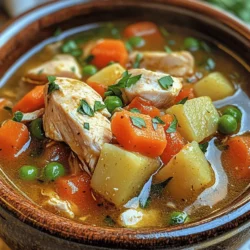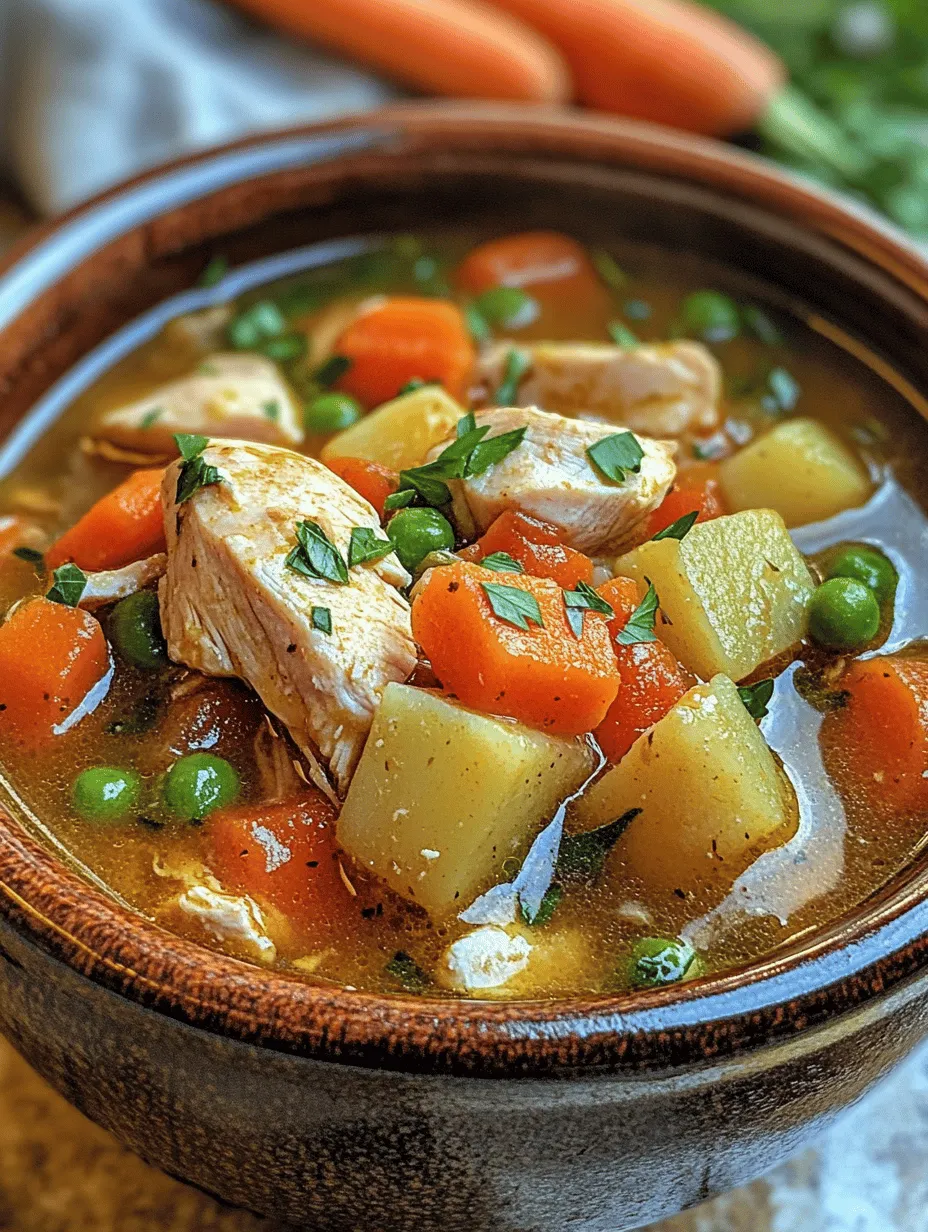Introduction
As the temperature drops and the days grow shorter, many of us find ourselves craving the warmth and comfort of hearty meals. Comfort food, in its many forms, plays a pivotal role during the colder months, providing not just nourishment but also a sense of nostalgia and home. One dish that embodies this essence is the warm and cozy hearty chicken and vegetable stew. This dish is a wholesome, nutritious meal that brings together tender chicken, vibrant vegetables, and rich flavors in a single pot—a true celebration of seasonal cooking.
Homemade stews have an array of benefits that make them a staple in many kitchens. First and foremost, they allow you to use fresh, seasonal ingredients which enhance the dish’s nutritional profile. When you prepare a stew from scratch, you have complete control over the flavors, allowing you to adjust spices and seasonings to suit your palate. Furthermore, preparing a hearty chicken and vegetable stew is straightforward, making it an accessible recipe for cooks of all experience levels. Whether you’re looking to feed a family or simply want a cozy meal for yourself, this stew is a perfect choice.
Understanding the Ingredients
To create a truly comforting chicken and vegetable stew, it’s essential to understand the role of each ingredient. Let’s take a closer look at the key components that will transform your stew into a delightful masterpiece.
Boneless, Skinless Chicken Thighs
The star of our stew is undoubtedly the chicken. Boneless, skinless chicken thighs are the ideal choice for this recipe due to their rich flavor and tender texture. Unlike chicken breasts, which can dry out during cooking, thighs remain juicy and succulent, even after prolonged simmering. They also absorb the flavors of the broth and spices beautifully, resulting in a deeply satisfying dish. Furthermore, chicken thighs are generally more economical than breasts, making them a smart choice for budget-conscious cooks.
Olive Oil
Using high-quality olive oil is crucial when sautéing ingredients for our stew. Not only does olive oil add a wonderful depth of flavor, but it also has health benefits, including heart-healthy fats and antioxidants. When selecting your olive oil, look for extra virgin varieties, as these offer the purest flavor and the highest nutritional value. The oil serves as the foundation for building flavor in the stew, so don’t skimp on this essential ingredient.
Fresh Vegetables
The vibrant array of vegetables in our stew not only enhances its nutritional value but also adds color and texture. Key vegetables include:
– Carrots: Sweet and earthy, they add natural sweetness and a satisfying crunch.
– Potatoes: A hearty staple, potatoes provide a comforting creaminess that helps to thicken the stew.
– Green Beans: With their bright color and crisp texture, green beans offer a refreshing contrast to the other ingredients.
– Celery: Often overlooked, celery contributes a subtle flavor and aromatic quality that elevates the overall dish.
Together, these vegetables create a balanced and nutritious base for our stew.
Diced Tomatoes
Diced tomatoes are a vital ingredient in many stews, as they contribute acidity and depth of flavor. The natural sweetness of tomatoes balances the savory elements of the chicken and vegetables while also adding a vibrant red hue to the dish. You can opt for canned diced tomatoes for convenience, but if you prefer fresh tomatoes, feel free to use them as well. Just be sure to peel and chop them before adding them to the pot.
Chicken Broth
The choice of broth can significantly impact the flavor of your stew. While store-bought chicken broth is convenient, making your own broth can elevate your dish to the next level. Homemade broth is richer and more flavorful, allowing you to control the salt content and add your own herbs and spices. If you’re short on time, high-quality store-bought broth is a suitable alternative. Choose low-sodium options to better manage salt levels in your stew.
Herbs and Spices
The final touch that brings our stew to life is the combination of herbs and spices. Fresh or dried thyme, oregano, and bay leaves are essential for enhancing the flavors of the stew. Thyme adds an earthy and slightly floral note, while oregano contributes a warm and slightly peppery taste. Bay leaves, when simmered, impart a subtle aromatic flavor that rounds out the stew. Remember to remove the bay leaves before serving, as they are not meant to be eaten.
Step-by-Step Preparation Guide
Now that we’ve explored the key ingredients that make this hearty chicken and vegetable stew so delightful, let’s dive into the step-by-step preparation process. This stew is not only delicious but also straightforward to prepare, making it perfect for both novice and experienced cooks.
Sautéing the Chicken
The first step in creating your stew is to sauté the chicken. Begin by heating a generous amount of olive oil in a large pot or Dutch oven over medium-high heat. Once the oil is shimmering, add the boneless, skinless chicken thighs. It’s important not to overcrowd the pot; if necessary, cook the chicken in batches to ensure even browning. Sauté the chicken for about 5-7 minutes on each side, or until it develops a beautiful golden-brown crust. This initial browning not only enhances the flavor of the chicken but also creates a delicious fond (the browned bits) at the bottom of the pot, which will enrich the stew as it simmers.
Cooking the Aromatics
Once the chicken is perfectly browned, remove it from the pot and set it aside on a plate. In the same pot, add a bit more olive oil if needed, and then toss in the chopped onions and minced garlic. Sauté the aromatics for 3-4 minutes, or until the onions become translucent and fragrant. This step is crucial, as the onions and garlic form the flavor base of your stew. Stir frequently to avoid burning the garlic, which can turn bitter and ruin the dish.
Adding the Vegetables
After the aromatics have softened, it’s time to introduce the vegetables. Start by adding the diced carrots and celery to the pot. Sauté these for about 5 minutes, allowing them to soften slightly while absorbing the flavors from the onion and garlic. Next, add the diced potatoes and green beans, stirring to combine. The goal here is to create a cohesive mixture of vegetables that will cook evenly in the stew.
Combining Ingredients
With the vegetables sautéed, it’s time to bring all the elements together. Return the browned chicken to the pot, along with any juices that have accumulated on the plate. Pour in the diced tomatoes and chicken broth, ensuring that the liquid covers the ingredients. This is also the moment to add your herbs and spices—toss in the thyme, oregano, and bay leaves. Stir everything together, ensuring that the chicken and vegetables are well-coated with the broth and seasonings.
At this stage, your stew is almost ready to go! Bring the mixture to a gentle boil, then reduce the heat to low and cover the pot. Allow the stew to simmer for about 30-40 minutes, or until the chicken is tender and the vegetables are cooked through. During this time, the flavors will meld beautifully, creating a rich and comforting dish that is sure to warm you from the inside out.
As you prepare this hearty chicken and vegetable stew, take a moment to enjoy the process. Cooking is not just about the final result; it’s about the love and care you put into each step. With each stir and simmer, you are creating a meal that can nourish both body and soul, making this recipe a true testament to the power of comfort food.

Simmering: The Science Behind Simmering and Its Impact on Taste and Texture
Once you’ve added all your ingredients into the pot, the magic truly begins when you start simmering your hearty chicken and vegetable stew. Simmering is a cooking technique that involves heating a liquid just below its boiling point, typically between 180°F and 205°F (82°C and 96°C). This gentle cooking method allows flavors to meld beautifully and ensures that the chicken remains tender while the vegetables soften without disintegrating.
The science behind simmering plays a critical role in developing the stew’s taste and texture. When simmered slowly, the collagen in chicken breaks down, enriching the broth and creating a luscious mouthfeel. Simmering also encourages the release of flavors from the herbs and spices, allowing them to infuse the entire dish. As the stew bubbles gently, it thickens and becomes heartier, creating a comforting and cohesive meal.
Allow your stew to simmer for at least 30 to 45 minutes. This duration allows the chicken to cook thoroughly while the vegetables become tender but still maintain some of their structure. The result is a dish that boasts a rich, complex flavor profile and a satisfying texture that warms the soul.
Final Seasoning: Importance of Tasting and Adjusting the Seasoning Before Serving
As your stew nears completion, it’s vital to taste and adjust the seasoning. The final seasoning step is not just a matter of preference; it can drastically enhance the overall taste of your stew. Use a spoon to take a small sample from the pot, and evaluate the flavors. Do you detect enough salt? Is it balanced with the right amount of acidity? Depending on your taste, you may want to add a pinch of salt, a dash of pepper, or even a splash of lemon juice to brighten the flavors.
Remember that seasoning is a personal journey. Each ingredient contributes to the overall flavor, and it’s essential to find the right balance that suits your palate. Fresh herbs, such as parsley or thyme, can be added at the end for an additional burst of flavor and freshness. Once you are satisfied with the seasoning, your hearty chicken and vegetable stew is ready to be served.
Nutritional Benefits of Chicken and Vegetable Stew
This hearty chicken and vegetable stew is not only a comfort food but also a powerhouse of nutrition. Let’s break down the nutritional profile of this dish to highlight its health benefits.
Protein Content from Chicken
Chicken is an excellent source of high-quality protein, essential for muscle development and repair. A serving of chicken in your stew can provide around 25-30 grams of protein, making it a satisfying and filling meal. The protein content helps keep you satiated for longer, which is beneficial for weight management and overall health.
Vitamins and Minerals from Vegetables
The variety of vegetables used in this stew contributes a wealth of vitamins and minerals. Carrots pack beta-carotene, which the body converts to vitamin A, crucial for eye health. Celery and onions provide fiber, which aids in digestion, while potatoes add potassium, supporting heart health. Additionally, leafy greens like spinach or kale can elevate the nutritional value even further, offering iron and calcium.
Health Benefits of Herbs and Spices
Don’t underestimate the health benefits of the herbs and spices in your stew. Garlic and onions are known for their anti-inflammatory properties and can boost the immune system. Thyme and rosemary not only add flavor but also contain antioxidants, which help combat oxidative stress in the body. By incorporating these ingredients, your stew transforms from a simple meal into a healthful dish.
Discussion on How This Stew Fits into a Balanced Diet
Incorporating a bowl of hearty chicken and vegetable stew into your meal plan fits seamlessly into a balanced diet. It contains a good mix of macronutrients: protein from chicken, carbohydrates from vegetables and potatoes, and healthy fats if you choose to include olive oil or butter for sautéing. The fiber from vegetables contributes to digestive health, making it a wholesome choice for lunch or dinner.
Variations and Customizations
One of the best aspects of this chicken and vegetable stew is its versatility. Here are some suggestions for variations and customizations to suit your taste preferences or dietary needs.
Suggestions for Ingredient Substitutions
If you’re looking to switch things up, consider substituting proteins. Turkey or lean beef can be excellent alternatives to chicken, or for a vegetarian version, chickpeas or lentils can be added for protein. For a lighter stew, you could even use fish like cod or salmon, adjusting cooking times accordingly.
In terms of vegetables, feel free to incorporate whatever is in season or available in your fridge. Bell peppers, zucchini, or even squash can add unique flavors and textures. Root vegetables like parsnips or turnips can enhance the earthiness of the stew.
Ideas for Modifying the Stew to Cater to Dietary Preferences
For those with specific dietary needs, this stew can be easily modified. To make it gluten-free, ensure that any broth or stock used is free from gluten. A low-carb version can be achieved by replacing potatoes with cauliflower or other non-starchy vegetables. Additionally, you can use coconut milk instead of broth for a creamy, dairy-free option that adds richness to the stew.
Creative Ways to Incorporate Seasonal Ingredients
Incorporating seasonal ingredients not only enhances flavor but also makes your stew more sustainable. In the fall, consider using butternut squash and sweet potatoes for a sweeter profile. In the winter, root vegetables like parsnips and turnips shine, while spring brings fresh peas and asparagus that can be added during the last few minutes of cooking to retain their crunch.
Serving Suggestions
After spending time preparing your hearty chicken and vegetable stew, the presentation and sides can elevate the experience even further.
Ideas for Pairing the Stew with Sides
This stew pairs beautifully with various sides. Crusty bread is a classic choice, perfect for sopping up the flavorful broth. For a heartier meal, serve it over a bed of fluffy rice or quinoa, which complements the stew’s richness. A fresh green salad with a tangy vinaigrette can also provide a refreshing contrast to the warm stew.
Presentation Tips for Making the Stew Visually Appealing
To make your stew visually appealing, consider serving it in rustic bowls that highlight its vibrant colors. Garnish with fresh herbs like parsley or cilantro for a pop of green. A sprinkle of black pepper or a drizzle of olive oil can add a professional touch. Presenting the stew with a slice of bread or a side salad can enhance the overall aesthetic, inviting your guests to dig in.
Discussion on Storing Leftovers and Reheating Techniques
If you find yourself with leftovers, you’re in luck! This stew keeps well in the fridge for up to three days. Allow it to cool completely before transferring it to an airtight container. When reheating, do so slowly on the stovetop or in the microwave, adding a splash of water or broth to maintain the desired consistency. The flavors often deepen and improve after a day, making leftovers a treat in their own right.
Conclusion
The warm and cozy nature of this hearty chicken and vegetable stew makes it the perfect dish for any occasion, whether it’s a family gathering or a quiet evening at home. The ease of preparation, combined with the wholesome ingredients, results in a delicious outcome that is sure to please everyone at the table.
Encouraging readers to try making this stew is a simple way to share comfort and nourishment with loved ones. The rich flavors, nutritional benefits, and customizable nature of this dish ensure that it can be enjoyed throughout the seasons. So gather your ingredients, follow the steps, and savor the delightful aroma that fills your kitchen as you create a meal that brings warmth and happiness to your home. Enjoy the experience of cooking and sharing this hearty stew with family and friends!


